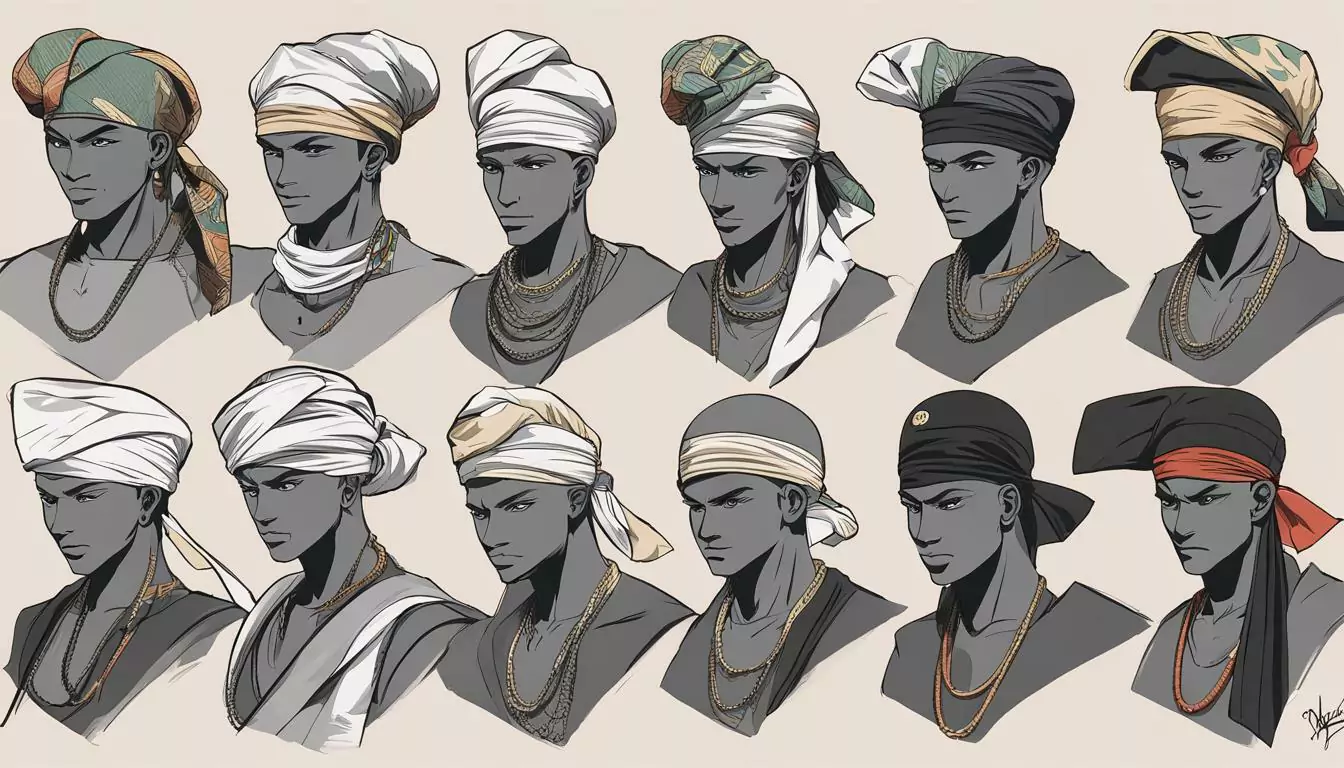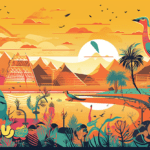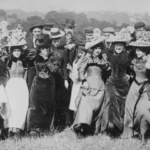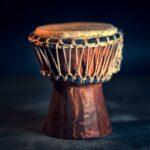Picture this: a piece of fabric, worn on the head, that tells a story as vivid as any tapestry. It’s called a durag, and its history is a captivating blend of culture, style, and empowerment. From its roots in ancient times to its modern-day significance, the durag has journeyed through centuries, carrying with it a profound meaning. Let’s unravel the threads of its past and discover why this iconic headwear has remained an enduring symbol of resilience and self-expression.
History of the Durag: From Humble Beginnings to Cultural Icon
The durag: that sleek, close-fitting headwrap we see everywhere today has a history as rich and layered as its fabric. It’s a story woven through centuries, reflecting resilience, creativity, and cultural evolution. We often associate it with contemporary style, but the durag’s roots likely reach far back to a time of struggle and survival.
Some believe the name “durag” itself might come from the phrase “do-rag,” highlighting its function as a protective covering. This theory is supported by the durag’s presence in the 19th century during the harrowing period of slavery in America. Enslaved African women, their hair often shaved or covered as a means of stripping identity, began using headwraps out of necessity. These wraps offered protection from the scorching sun and harsh elements while also serving as a way to manage their hair. Though born out of oppression, these headwraps became a subtle act of defiance, allowing women to reclaim a sense of dignity and self-expression.
Fast forward to the early 20th century, a period brimming with cultural shifts and artistic awakenings. The Harlem Renaissance was in full swing, and during this time, the durag, as we know it today, began to take shape. It became particularly popular among Black men and women during the Great Depression, offering a practical way to maintain their hairstyles, especially waves, curls, and intricate designs, amidst economic hardship.
But the durag was more than just a practical accessory; it became a symbol of identity and community. It represented a connection to African heritage and a celebration of Black beauty in a society rife with prejudice. This symbolism became even more prominent during the Civil Rights Movement of the 1960s and ’70s, where durags, alongside afros and dashikis, became a visible symbol of Black pride and resistance.
Then came the 1980s and ’90s, decades that witnessed the explosion of hip-hop culture onto the global stage. Iconic figures like Jay-Z, Nelly, and countless others incorporated the durag into their signature looks, instantly elevating it from a functional head covering to a powerful fashion statement. The durag became synonymous with hip-hop style, representing swagger, confidence, and an undeniable coolness. This influence continued with rappers like A$AP Ferg and the growing popularity of the waves hairstyle.
However, the durag’s journey hasn’t been without its challenges. Its association with Black culture, particularly within the context of hip-hop, led to its stigmatization in some circles. It was often misconstrued as a symbol of rebellion or gang affiliation, resulting in its ban in certain spaces, such as the NFL and NBA in 2005.
Thankfully, perceptions continue to evolve. In recent years, the durag has experienced a resurgence, breaking free from stereotypes and gaining wider acceptance. High-profile designers have embraced its unique aesthetic, incorporating it into their runway shows and showcasing its versatility. Remember Solange Knowles’ stunning durag at the 2018 Met Gala? That moment exemplified the durag’s ability to transcend cultural boundaries and become a powerful symbol of style and empowerment. Even Rihanna’s Vogue cover showcasing a durag marked a milestone in its recognition.
Today, the durag’s journey is far from over. It remains a versatile accessory, embraced for both its practicality and its cultural significance. It’s a symbol of resilience, creativity, and the enduring legacy of Black culture. And as we move forward, it’s up to all of us to appreciate the durag’s rich history and challenge the stereotypes that have been unjustly associated with it.
What is the Origin of the Durag?
We’ve already talked a bit about what durags are and how they’re used, but let’s delve a little deeper into where this iconic headwrap came from. Its a fascinating journey through history, intertwined with struggles, resilience, and ultimately, a powerful expression of identity.
From Practicality to Pride: Tracing the Durag’s Roots
You see, the durag didn’t start out as a fashion statement. It actually goes all the way back to the 19th century, during a really tough time in American history – the era of slavery. Back then, enslaved African women, forced into grueling labor under the scorching sun, needed a way to protect their hair.
That’s where the durag came in. It was a simple, practical solution – a piece of cloth tied around the head to keep hair clean and shielded from the elements.
A Symbol is Born: From Fields to Freedom and Beyond
Now, here’s where things get really interesting. As time passed, and especially during the 1930s amidst the hardships of the Great Depression and the cultural awakening of the Harlem Renaissance, the durag took on a whole new meaning.
It evolved from a necessity to a symbol of defiance, pride, and a way for African Americans to express their identity. It became a visual representation of their heritage and resilience in the face of adversity. The first published record of the “Do Rag” appeared in 1966, described as a sweatband and hair cover. Later, in the late 1970s, companies like So Many Waves popularized the “Tie-down” for hair styling and wave creation, further solidifying its place in hair care and cultural expression.
Hip-Hop and Beyond: The Durag’s Enduring Legacy
Fast forward to the 1990s, and the durag found a new wave of popularity through hip-hop culture. Rappers, athletes, and artists embraced it, making it a staple of urban fashion and a powerful symbol of Black culture. #Wavecheck videos on social media further highlight this connection, showcasing the competitive spirit and artistry associated with achieving the perfect wave pattern.
Today, the durag continues to hold a special place in society. It’s a versatile headwrap used for a variety of purposes – from maintaining hairstyles and creating those sought-after waves to making bold fashion statements and paying homage to a rich cultural heritage.
While we can trace its roots back centuries, the durag’s story is far from over. It continues to evolve, carrying with it layers of history, significance, and personal meaning.
Why Did Enslaved People Wear Durags?
We’ve talked about the history of durags, but let’s dive a bit deeper into why enslaved people started wearing them in the first place. Imagine working under the scorching sun, doing back-breaking labor all day. Now, imagine doing that with no protection for your hair or scalp.
That was the reality for many enslaved African Americans on plantations. Durags, probably made from scraps of cloth at the time, offered some much-needed relief. They helped keep the hair tidy, prevented dirt and sweat from building up, and provided a little bit of shade from the relentless sun. Think of it as a practical solution born out of necessity in a time when even basic comforts were often denied.
It’s interesting how something initially worn for purely practical reasons can evolve to take on a whole new meaning, isn’t it? Over time, the durag became more than just a head covering; it became a symbol of shared experience and identity. Even after slavery, this simple piece of cloth continued to hold deep cultural significance.
What is the Purpose of a Durag?
Durags aren’t just a fashion statement; they’re like a secret weapon for hair care, especially for those with textured hair. Think of them as a protective shield for your hair. You know how the wind, sun, and even just rubbing against a pillow can mess up your hair? Well, durags act as a barrier against all that. This is especially important for hair that’s prone to breakage or dryness, as it helps keep those strands strong and healthy.
But it’s not just about protection. Durags are like a styling tool too. Ever wonder how people get those super defined waves or keep their braids looking fresh? A durag is often the secret weapon! The fabric helps to hold those styles in place, preventing frizz and keeping everything looking neat and tidy.
And if you’re trying to grow out your hair, a durag might just be your new best friend. Some people believe that the gentle compression from a durag can actually promote blood flow to the scalp. This extra blood flow can, in turn, stimulate the hair follicles and potentially even encourage faster hair growth. While more research is needed to definitively say for sure, it’s a theory that many people stand by.
Beyond the practical benefits, durags also hold cultural significance, particularly within the African American community. They represent a connection to heritage, a symbol of pride in natural hair textures. What started as a practical solution for protecting hair has evolved into a powerful statement of identity.
While there might be some misconceptions surrounding durags, it’s important to remember that like any piece of clothing, their meaning and purpose can be varied. They can be a fashion statement, a tool for hair care, and a symbol of cultural pride, sometimes all at the same time!
Why Do Black Guys Wear a Durag?
You know how some folks see a durag and just think it’s about keeping your hair neat? Well, it’s way deeper than that. For many Black guys, a durag is like a statement piece, you know? It’s about repping their culture, showing love for their community, and keeping traditions alive.
Think about it, durags have been around for ages. They’ve been there through thick and thin, from the tough times of slavery to the fight for civil rights and even now, making waves in the world of hip-hop. Each generation has rocked the durag in their own way, making it a symbol of resilience, standing up for what you believe in, and of course, looking fly.
These days, you’ll still catch a lot of Black guys sporting durags. Sure, it helps keep their hair looking sharp, but it’s more like a badge of honor, a way of saying, “This is me, and I’m proud.” It’s a powerful reminder of the journey Black people have been on and how far they’ve come, but also a nod to the work that still needs to be done.
What Culture Wears Durags?
While you’ll see people from all walks of life sporting durags these days, they’re most closely tied to Black culture, especially in the United States. Think of it like this: jeans started as workwear but evolved into a fashion staple embraced by diverse groups, yet they still hold a special place in American culture. Durags follow a similar thread.
Their journey goes way back, all the way to the difficult era of slavery in the U.S. For enslaved Africans, durags weren’t just about style; they were a necessity. Imagine toiling under the scorching sun – a durag would’ve been crucial for shielding hair from the elements and keeping it tidy during laborious tasks.
Fast forward to the Civil Rights Movement of the 1960s and 70s, durags took on a powerful new meaning. They became a visible symbol of Black pride and resistance, embodying the spirit of the Black Power movement alongside afros and dashikis. Think of it as a silent statement, reclaiming and celebrating Black identity.
Then came the 80s and 90s, when hip-hop and R&B artists put their spin on durags. Run-D.M.C., Tupac, and countless others incorporated durags into their signature looks, making them synonymous with a cool, rebellious vibe. It was a way to express individuality within a vibrant cultural movement, much like how certain hairstyles or clothing items become synonymous with specific music scenes today.
Today, durags are like cultural chameleons. Yes, they’re still a powerful emblem of Black identity, but they’ve also transcended their initial symbolism. You’ll spot athletes wearing them for practical reasons (think basketball players keeping their hair in check), and fashion enthusiasts incorporating them into diverse styles. It’s similar to how Henna, once primarily associated with South Asian cultures, is now embraced by people globally for its artistic beauty.
But even with their growing popularity outside Black communities, it’s important to recognize and respect the deep cultural significance durags hold. They’re a reminder of resilience, creativity, and the ever-evolving nature of culture itself.
Why Do Guys Wear Durags to Sleep?
You already know durags are like a magic trick for hair, right? But did you know that a lot of guys actually wear them to bed? It might seem a little strange at first, but it actually makes a lot of sense. Think about it: when you sleep, your hair rubs against your pillow all night long. This friction can cause your hair to break and get tangled, which nobody wants. Durags act like a shield, protecting your hair from all that rubbing and keeping it safe from damage.
But that’s not all! Imagine waking up with bedhead so epic, it would make Einstein jealous. Not a good look, right? Well, durags can be your secret weapon against morning hair disasters. Whether you’ve spent hours perfecting your waves, braids, or twists, a durag will help you keep that style locked in all night long. No more waking up looking like you stuck your finger in an electrical socket!
Speaking of waves, durags are like the holy grail for achieving those perfectly sculpted ripples. See, when you wear a durag to sleep, it creates this gentle pressure that pushes your hair down against your scalp. This helps those natural oils in your hair spread out evenly, which is the key to getting those waves looking smooth, shiny, and healthy.
But wait, there’s more! Some people believe that wearing a durag can actually help prevent hair loss. Now, hair loss can be a tricky business with lots of different causes, but friction and breakage definitely play a role. Durags can help minimize these issues by creating that protective barrier we talked about, which might lead to a healthier scalp and less hair falling out. It’s like giving your hair a cozy little hug all night long!
And the best part? Durags are like the cool kids in school – everyone’s invited! No matter what type of hair you have – short, long, curly, straight – there’s a durag out there for you. They come in all sorts of sizes and fabrics, so you can find the perfect one to keep your hair looking its best.
Think of it this way:
| Benefit | How it Works |
|---|---|
| Prevents Breakage | Acts as a barrier against friction from your pillow. |
| Maintains Hairstyles | Holds your chosen style in place while you sleep. |
| Enhances Waves | Promotes even distribution of natural oils for smoother, healthier waves. |
| May Reduce Hair Loss | Minimizes breakage and helps maintain a healthy scalp, potentially reducing hair loss. |
| Suits All Hair Types | Available in various sizes and materials to accommodate different hair lengths and textures. |
So, there you have it! The next time you see someone rocking a durag, remember it’s not just a fashion statement – it’s a whole nighttime hair care routine!
What Does “Durag” Mean in Slang?
Picking up where we left off, let’s dive a bit deeper into how the word “durag” itself is used in everyday conversations. While we know it refers to that sleek headwear, its meaning in slang can be a bit more nuanced and layered.
Often, you’ll hear “durag” thrown around as a synonym for the headwrap itself. It’s like saying “sneakers” instead of “athletic shoes” – just a shorter, more casual way to get the point across. You might hear someone say, “Yo, pass me my durag, my hair’s a mess!” It’s straightforward and simply refers to the item itself.
But there’s more to it than just fabric and style. The durag holds a deeper significance, particularly within Black communities worldwide. It’s intertwined with cultural identity and pride, representing a shared heritage and a sense of belonging.
This cultural weight adds another layer to how “durag” is used in slang. It can be a subtle nod to shared experiences, a way of expressing solidarity, or even a term of endearment within certain circles.
Think of it like this: language is constantly evolving, and slang, in particular, is deeply connected to shared experiences and cultural identity. The way we use words reflects not just their dictionary definitions but also the rich tapestry of history, community, and expression.
So, while “durag” might simply mean “headwrap” to some, to others, it’s a loaded term packed with cultural significance and meaning. It’s a reminder that language is fluid, dynamic, and constantly shaped by the communities that use it.
Did Egyptians Wear Durags?
We’ve been talking about headwear and history, and you might be wondering about the connection between ancient Egypt and durags. While the Egyptians were known for their elaborate hairstyles and headwear, durags as we know them today weren’t part of their fashion scene.
Some historians suggest that the head coverings observed in ancient Egyptian hieroglyphics could indicate a loose connection to the concept of headwraps for hair protection. However, these are separate cultural practices with distinct origins and significance.
Durags actually have their roots in a much different time and place. Think back to the difficult period of slavery in America. African women, forced into hard labor, needed a way to protect their hair. They started using any spare fabric they could find to wrap their heads, and this practice eventually evolved into what we now know as the durag.
Over time, the durag became more than just a practical solution for hair protection. It transformed into a powerful symbol of African American identity. During the 1960s, the Black Power movement embraced the durag, further cementing its connection to Black culture and pride.
But what makes the durag so special? Well, it’s incredibly versatile. Not only does it protect hair, but it also helps create those smooth, sculpted waves that have become iconic. It’s like a secret weapon for hair care, locking in moisture and preventing damage.
Today, the durag has broken free from its purely functional origins and stepped onto the global fashion stage. From musicians and athletes to designers and everyday people, the durag has become a statement piece. It’s a fascinating blend of history and style, representing cultural heritage while adding a cool factor to any look.
It’s worth noting that our understanding of the durag’s history is still evolving. Researchers continue to uncover new information, and there’s always more to learn about this simple yet profound piece of fabric.
What Does a Durag Do for Straight Hair?
Okay, so you’ve got straight hair and you’re curious about durags. Maybe you’ve seen people rocking them and wondered if they could work for you too. Let’s break it down.
You might think of durags as something mainly for curly or coily hair, but they can actually do some cool things for straight hair too. The trick is, it’s not about changing your hair texture from straight to curly. It’s more about subtly influencing how your hair lays and behaves.
1. Think Texture, Not Curls:
Imagine this: you put on a durag and instead of your hair just lying flat, it gets this slight wave or bend to it. That’s what a durag can do. It won’t magically give you ringlets, but it can add a bit of dimension and make your hair look less uniform. You know, a little less ‘just brushed’ and a little more ‘interesting’.
2. Keeps Your Style on Lock (Literally):
Ever spend time perfecting your hair, only for it to go flat or lose its shape in no time? Durags can be your new best friend. They act like a gentle hair net, holding your style in place. So, if you’ve gone through the effort of styling, a durag can help you keep that look going strong.
3. Protection is Key:
Think of a durag like a shield for your hair. It creates a barrier against things that can cause damage, like the sun’s rays, wind, even just rubbing against your pillow at night.
4. Could a Durag Help Your Hair Grow?
Okay, this one is interesting. Some people believe that wearing a durag can actually encourage hair growth. Here’s the theory: the durag helps to stimulate blood flow to your scalp because of the gentle pressure it creates. And better blood flow means happy hair follicles. Plus, by reducing friction, a durag might also help minimize breakage. Now, more research is definitely needed in this area, but it’s a cool possibility, right?
The Bottom Line:
Durags aren’t just a fashion statement, they can be a helpful tool for anyone with straight hair who wants to play with texture, preserve their style, and maybe even give their hair a little extra TLC. It’s all about trying it out and seeing what works for you!
Who Criminalized Durags?
Picking up where we left off, we really need to unpack how durags, something so central to Black culture, ended up being seen as something negative, even criminal. It’s not like there was a single law passed that said, “Durags are illegal, full stop.” Instead, it was more of a gradual process, rooted in biases and stereotypes.
Think about how the NFL and NBA banned durags back in 2005. Their reasoning? They claimed it was a safety issue. But, a lot of people saw right through that, viewing it as a thinly veiled attempt to stifle a cultural expression that was predominantly associated with African Americans. It felt like they were saying, “This is how we do things here,” and that “we” didn’t include Black culture the way it was.
This whole situation shines a light on the bigger issue of systemic discrimination that Black communities face. It’s about more than just a piece of cloth on someone’s head. It’s about how certain groups are disproportionately targeted and how their cultural expressions are often misunderstood or misconstrued.
What we’re seeing with durags is just one piece of a much larger puzzle. It’s tangled up with things like racial profiling, the over-policing of Black bodies, and the constant pressure to conform to standards that weren’t designed to include them.
It’s important to remember that despite these attempts to demonize them, durags remain a powerful symbol of Black pride and resilience. They represent a refusal to bow to pressure and a commitment to preserving cultural identity. This conversation is far from over, and it’s crucial that we keep talking about it, challenging the status quo, and pushing for a more inclusive and equitable future.
For more insights into the rich tapestry of history and culture, explore these related topics:
- For the complete history of the iconic Bud Billiken Parade, follow the link.
- For a detailed podcast on the profound history of the Crusades, click here.
- Interested in a well-rounded take on the fascinating history of the Gideons? Explore the link.









